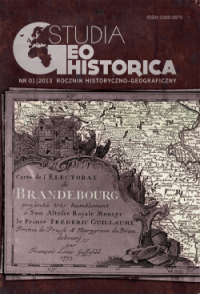Mapa józefińska Galicji (1779–1783) w przededniu edycji. Przedmiot i założenia programu wydawniczego
Josephine map of Galicia (1779–1783) on the eve of the edition. The subject and assumptions of the publishing plan
Author(s): Andrzej Janeczek, Waldemar BukowskiSubject(s): Historical Geography, Maps / Cartography
Published by: Polskie Towarzystwo Historyczne
Keywords: historia kartografii;mapy topograficzne;dawne mapy Galicji;history of cartography;topographic maps;old maps of Galicia
Summary/Abstract: As a result of the first partition of Poland (1772) Austria occupied two big districts, namely the southern part of Lesser Poland and Red Ruthenia. Th e newly incorporated crownland, called the Kingdom of Galicia and Lodomeria, was mapped within Josephine survey already a few years after annexation. The name of Josephine survey (or the first military survey) refers to a series of topographic maps made in the years 1763–1787, which covered the successive territories under the rule of the Habsburg dynasty (fi g. 1). In the case of the map of Galicia, the same principles were adopted as those for the whole Josephine survey. Th e map was prepared in a 1:28 800 scale model on the basis of field measurements but also using the „a la vue” method, with a plane table and other instruments. Th e Josephine map of Galicia, initially made secret due to its military importance, was never published and remains in a manuscript till now, kept in the War Archives in Vienna. It consists of 413 sheets in the format of 24 × 16 inches (63.2 × 42.1 cm) and additional sheets of varying formats. Its total surface is about 115 m2. Two sets of hand-written copies (fi g. 3) have been preserved besides the original (an example in fi g. 2). Th e map is accompanied by six bulky volumes including descriptions of the mapped area (one of the sheets is presented in fi g. 4). Due to the value of the map as a source and its usefulness for historical as well as geographical studies and studies conducted within other disciplines, postulates were put forward for this relic to be made available in print. Those intentions were made specific in 2008, when work was begun on preparing a full edition of Galicia’s map which would include both the cartographic material and the text (topographic descriptions). Four editorial groups are concerned with this and they are headed by Waldemar Bukowski (Institute of History of the Polish Academy of Sciences, Cracow), Zdzisław Noga (Institute of History, Pedagogical University of Cracow), Andrzej Janeczek (Institute of Archeology and Ethnology of the Polish Academy of Sciences, Warsaw) and Zdzisław Budzyński (Institute of History of the University of Rzeszów). Th e material was divided into fifteen volumes of a similar size (fi g. 5). Each volume will be composed of two volumes. One will include facsimiles of the sheets of the map, from 20 to 46. Th e other volume will contain texts of descriptions in German with a parallel translation into Polish, commentaries to the descriptions, an inventory of names included in the map, a joint index of maps and descriptions and, finally, explanations to the symbols and the map captions. Further plans provide for a digital version on the basis of the prepared material of the printed version.
Journal: Studia Geohistorica
- Issue Year: 2013
- Issue No: 1
- Page Range: 91-112
- Page Count: 22
- Language: Polish

